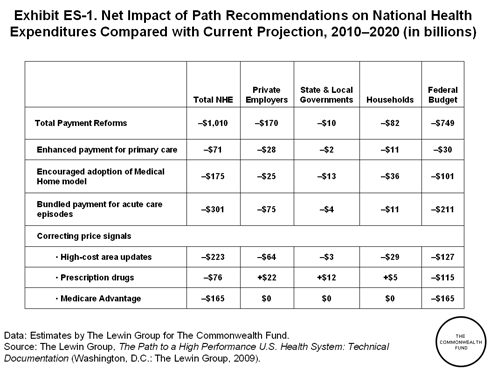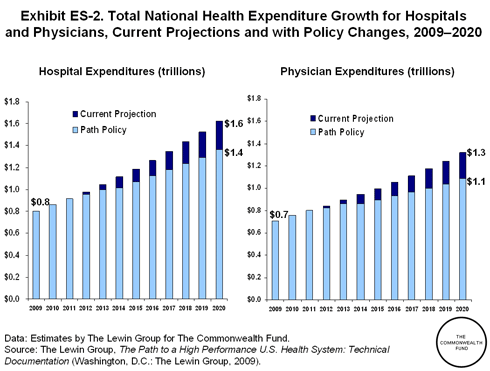In its report, The Path to a High Performance U.S. Health System: A 2020 Vision and the Policies to Pave the Way, the Commonwealth Fund Commission on a High Performance Health System recommended an integrated set of reforms for changing the way the nation pays for health care, in order to reward high-quality care and prudent stewardship of resources and to encourage reorganization of the health care delivery system. This report describes the Commission’s payment reform recommendations in greater detail. It illustrates how the reforms might be applied and what their impact would be if implemented on a foundation of universal health coverage combined with system reforms that provide information for better decision-making and improve population health.
The Commission-recommended payment reforms seek to improve value by providing incentives and support for a more accessible, effective, and efficient health delivery system. The reforms would:
- Strengthen and reinforce primary care by revising the Medicare fee schedule to enhance payment for primary care services and to ensure annual increases that keep pace with the cost of efficient practice;
- Institute new ways of paying for primary care to encourage adoption of the medical home model and promote more accessible, coordinated, patient-centered care, with a focus on health and disease prevention;
- Promote more effective, efficient, and integrated health care delivery by
adopting more bundled payment approaches to paying for care over a period of time or for the duration of an illness, with rewards for quality, outcomes, and efficiency; and - Correct price signals in health care markets to better align payments
with value.
To estimate the potential effects of these payment reforms, Commission staff developed and modeled specific policies that followed the recommendations. The analysis of these policies examines their impact on total spending compared with projected trends and also on spending by households, employers, and federal and state and local governments. The results indicate that, by increasing emphasis on primary care, improving coordination, and eliminating unnecessary and duplicative services, these payment reforms could slow growth in total health care spending by a cumulative $1 trillion through 2020, compared with baseline projections (Exhibit ES-1). This figure represents about one-third of the overall system savings of $3 trillion projected for the Commission’s integrated set of recommendations. The additional savings result from a reduction in insurance administrative costs, investment in a sounder information infrastructure for the health system (e.g., health information technology and comparative effectiveness), and measures to improve public health.

The $1 trillion savings from payment reforms would accrue to all payers, including the federal government ($749 billion), employers ($170 billion), households ($82 billion), and state and local governments ($10 billion). These estimates rest on the assumption that insurance would be available to all and that payment reforms would apply to Medicare, Medicaid, and a new public health insurance plan to be offered as an option along with private insurance choices through a national health insurance exchange. The estimates assume that some private payers will voluntarily adopt the payment reforms; if most or all private payers adopted the reforms, there would be additional savings to employers and households.
The effects of the payment reforms depend upon their being pursued simultaneously with coverage and system reforms. Covering all or nearly all of the uninsured would eliminate the need for implicit cross-subsidies from private insurers to meet the costs of their care. To align incentives and promote equity, Medicaid payment would be raised to Medicare levels. Coverage of the uninsured and improvements in Medicaid payment would improve the fiscal stability of safety-net providers. Offering a public health insurance plan that would adopt the recommended payment reforms—and encouraging private payers to follow suit—would strengthen the emphasis on efficiency and value. Investing in better information systems would further enhance the effectiveness of payment reforms and enable delivery system change and innovation.
These payment reforms offer significant opportunities for health care providers to benefit from improving care and making prudent use of resources. The new payment methods reward value rather than volume. Although provider revenues would grow more slowly over the next decade, they would continue to grow (Exhibit ES-2). Projected national health expenditures under the integrated set of Path report recommendations would increase to $4.6 trillion in 2020—up 73 percent from the $2.6 trillion estimated for 2009. Although that is lower than the $5.2 trillion projected for 2020 in the absence of reform, spending on hospitals and physicians would continue to increase. Furthermore, if providers respond positively by increasing the efficiency of the services they deliver and cut out waste and duplication, ample opportunities exist for growth in their net revenues and margins.

While embarking on payment reform may be daunting for stakeholders, given the large investment they have in the current system, new and innovative strategies are needed to align incentives to encourage and reward more effective and efficient care—improving the performance of the health system for those it is intended to serve, while making the system more sustainable for all those who provide, receive, and pay for care.